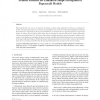Free Online Productivity Tools
i2Speak
i2Symbol
i2OCR
iTex2Img
iWeb2Print
iWeb2Shot
i2Type
iPdf2Split
iPdf2Merge
i2Bopomofo
i2Arabic
i2Style
i2Image
i2PDF
iLatex2Rtf
Sci2ools
EUROGRAPHICS
2010
Eurographics
2010
Eurographics
Printed Patterns for Enhanced Shape Perception of Papercraft Models
Papercraft models can serve as inexpensive prototypes in shape design applications. However, in making the models some geometric detail is necessarily lost, and artificial creases may be visible, thereby limiting the utility of these models. To compensate for these practical limitations, we introduce the use of printed patterns on papercraft models to enhance the perception of the shape they are intended to represent. We propose pattern generation schemes that modulate the sizes, directions, and densities of glyphs of patterns based on geometric attributes. We present a psychophysical experiment designed to explore the effect that printed patterns have on the perception of the papercraft model shapes. We find that models with printed patterns are perceived to represent the intended shape more accurately, and, further, that the type of printed pattern has an impact on the perceived shape. Categories and Subject Descriptors (according to ACM CCS): I.3.1 [Computer Graphics]: Hardware A...
Computer Graphics | EUROGRAPHICS 2010 | Papercraft Model Shapes | Papercraft Models | Shape Design Applications |
| Added | 11 Mar 2010 |
| Updated | 15 Mar 2010 |
| Type | Conference |
| Year | 2010 |
| Where | EUROGRAPHICS |
| Authors | Su Xue, Xuejin Chen, Julie Dorsey, Holly Rushmeier |
Comments (0)

